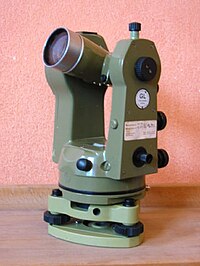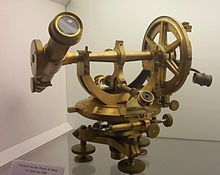Fine movement

In opto-mechanical measuring instruments, fine movement is a device with which the instrument can be rotated slightly around a (mostly vertical or horizontal) axis . It is operated by a knurled or knurled knob, and on computer-controlled devices also by arrow keys .
In older instruments (up to around 1980), the fine movement itself consists of a threaded spindle with which an arm clamped to the horizontal or vertical circle or a swiveling worm gear is moved. In newer devices, the rotation is done electrically, for example with stepper motors , the speed of which can be regulated.
Instruments for measuring angles
Theodolites , universals and similar geodetic instruments each have a fine movement for the vertical and horizontal axes. Rotations around the vertical standing axis correspond to a small change in the horizontal direction of the measuring telescope , those around the horizontal tilt axis correspond to a change in the elevation angle . The rotary knobs are usually attached to the telescope supports on the eyepiece side. A quarter turn corresponds to about 0.05 to 0.1 °, so that clearly visible targets can be set to a few angular seconds.
Modern second theodolites and tachymeters often have a two-speed fine movement, which even enables measurements to ± 1 ". The circular readings are made in a measuring microscope right next to the telescope eyepiece.
Sextants only have a fine movement, which engages directly in the worm gear of the measuring circle ( arc in the picture ). One rotation corresponds to 1 degree, the arc minutes are read on the micrometer drum and added to the degree value of the measuring circle.
Even with leveling devices, there is only one (horizontal) fine movement. Most of the time, it is a worm wheel that sits on friction and is turned manually in the direction of observation and then adjusted to the measuring stick with the fine drive.
Astronomical instruments
While hand-held telescopes or observation telescopes are moved manually, astronomical telescopes, depending on their size, have a massive mount with clamping and fine movement for both axes. The only exception are the Dobsonian telescopes , which are usually not installed when they are simply mounted.
The mount is either azimuthal or equatorial (parallactic) depending on the complexity .
Small amateur telescopes (picture on the left) usually have flexible shafts as a fine movement that access the worm wheels of the two axes. This solution, which is very inexpensive for small wheel diameters, has the disadvantage that the movement cannot be precisely metered and is often jerky. Tracking the stars more precisely than to a tenth of a degree is hardly possible.
Medium-sized amateur telescopes - for example from the six- or eight-inch - usually have an equatorial mount with manual or electrical tracking . In older instruments, the fine movement of the declination and hour axes mostly acts on an arm with a threaded spindle that is clamped to the axis , the rotation of which is operated by the observer directly or via a shaft. In the case of mounts with stepper motors , on the other hand, their speed is controlled via a resistor, or with go-to mounts via a handheld computer .



